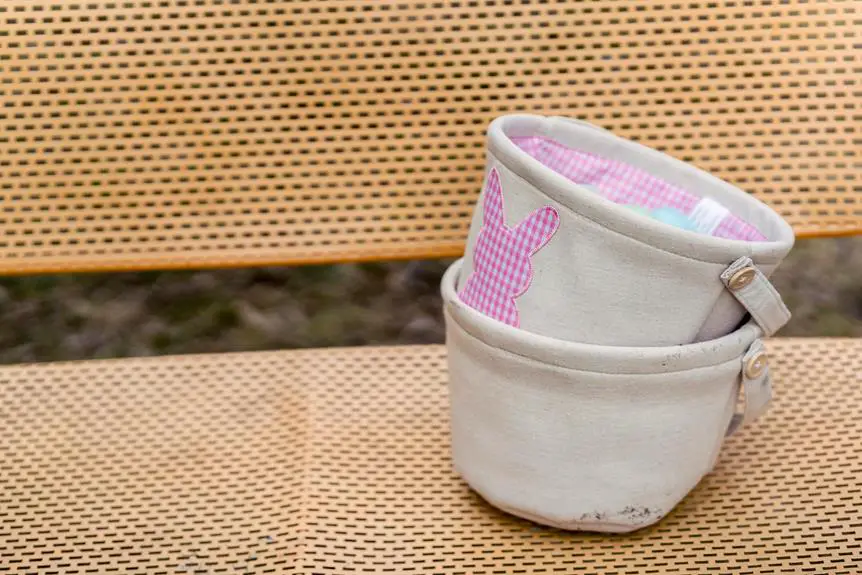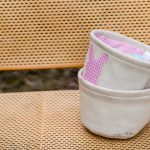When you're looking to appliqué on various fabric types, it's crucial to understand how each material behaves. For instance, cotton allows for straightforward techniques, while stretchy fabrics require a different approach to avoid distortion. You might find that delicate silks demand extra care to maintain their elegance. It's also essential to consider the right tools and preparation techniques to ensure a clean finish. Curious about the specific methods for each fabric type and how to achieve the best results? Let's explore that further.
Table of Contents
Key Takeaways
- Prewash and iron fabrics to remove chemicals and ensure a smooth surface for better adhesion during appliqué.
- Use appropriate stabilizers for stretchy or slippery fabrics to maintain shape and prevent distortion while stitching.
- Choose suitable stitching techniques, like zigzag for knits and satin stitch for delicate silk, to enhance the final appearance.
- Select contrasting fabrics for denim appliqué to make designs stand out, securing them with fabric glue or fusible webbing.
Understanding Fabric Types
When you start working with appliqué, it's essential to understand the various fabric types you'll encounter and how they can affect your project. Different fabrics behave uniquely during the appliqué process, influencing everything from stitching to adhesion.
For instance, cotton is a popular choice due to its versatility and ease of use. It holds shapes well and responds nicely to various stitches.
On the other hand, stretchy fabrics like knits require special handling. You'll need to use stabilizers to prevent distortion during stitching. If you choose a slippery material, like silk or satin, consider using a temporary adhesive to keep everything in place while you sew.
Denim and canvas are heavier options that provide durability but may require a stronger needle and thread. Each fabric type presents its own challenges, so knowing them helps you prepare adequately.
Lastly, always prewash your fabrics to avoid shrinkage after your project is complete. By recognizing the characteristics of each material, you can select the right one for your appliqué project and ensure a smoother sewing experience.
Your choice of fabric can make or break your final result, so choose wisely!
Cotton Appliqué Techniques
When working with cotton for appliqué, you'll want to focus on proper fabric preparation to ensure your designs come out clean and crisp.
Understanding different stitching methods can also make a big difference in the overall look of your project.
Let's explore these essential techniques to enhance your cotton appliqué skills.
Fabric Preparation Tips
Preparing your cotton fabric properly is essential for achieving clean and precise appliqué results.
Start by prewashing your fabric to remove any sizing or chemicals that could affect the adhesion of your appliqué. Use a gentle detergent and avoid fabric softeners, as they can leave a residue that interferes with the process.
Once your fabric is clean, press it with a hot iron to eliminate any wrinkles. This step ensures your fabric lays flat, making it easier to work with. If your cotton has a tendency to fray, consider applying a thin layer of interfacing to the back. This will help stabilize the fabric and keep edges crisp.
After prepping, cut your appliqué pieces carefully, using sharp scissors to ensure smooth edges. You might also want to use a rotary cutter and mat for more precision, especially for intricate designs.
Lastly, consider using a light fusible webbing between your fabric layers for added stability and ease of application.
Stitching Methods Overview
Choosing the right stitching method is crucial for securing your cotton appliqué pieces and enhancing the overall design. You've got several options, each with its own benefits and applications.
First, consider using a straight stitch. It's straightforward and ideal for simple designs where you want a clean finish.
If you're feeling a bit adventurous, a zigzag stitch can add texture and help secure edges, making it perfect for raw-edge appliqué.
For a more decorative touch, try a satin stitch. This method creates a dense, smooth finish that beautifully outlines your appliqué shapes. Just keep in mind that it's best for smaller pieces, as it can be time-consuming.
If you're looking for a quick and easy option, a blanket stitch is a great choice. It provides a charming, rustic look, especially for larger appliqués.
Appliqué on Denim
Appliqué on denim can add a stylish touch to your favorite jeans or jackets, making them uniquely yours. To start, choose a denim piece that you want to embellish. Select a contrasting fabric for your appliqué; vibrant colors or patterns work well against the classic blue denim. Trace the desired shape onto this fabric, cut it out, and then prepare it for application.
Next, you'll need to secure the appliqué in place. You can use fabric glue or double-sided fusible webbing for a quick fix. If you prefer a more durable option, use a zigzag stitch or a straight stitch around the edges. Remember to set your sewing machine to a shorter stitch length to ensure a clean finish.
When you're stitching, keep the denim fabric taut but not stretched. This helps prevent puckering. After you've finished stitching, trim any excess threads and give your work a gentle press with an iron.
Working With Silk
When working with silk, you'll want to prepare the fabric carefully to ensure the best results.
Choosing the right stitching techniques is crucial since silk is delicate and can easily fray.
Let's explore how to handle silk for your appliqué projects effectively.
Preparing Silk Fabric
To ensure your silk fabric is ready for appliqué, start by washing it gently to remove any sizing or chemicals that could interfere with your project. Use cool water and a mild detergent specifically designed for delicate fabrics. Avoid wringing or twisting the silk; instead, allow it to soak for about 10-15 minutes before rinsing it thoroughly.
Once washed, lay the silk flat on a clean, dry towel to absorb excess moisture. Never hang it to dry, as that could distort its shape. After it's dry, press the fabric lightly with an iron set on a low temperature. Always place a pressing cloth between the iron and the silk to prevent scorching or shiny spots.
Next, it's essential to stabilize the silk before you start appliquéing. You can use a lightweight fusible interfacing or a tear-away stabilizer on the back. This step helps prevent fraying and distortion during stitching.
Stitching Techniques for Silk
Choosing the right stitching techniques for silk is crucial to achieving a polished and professional look in your appliqué projects. Since silk is delicate and can fray easily, you'll want to select methods that enhance its natural beauty without causing damage.
Here are three effective stitching techniques to consider:
- Straight Stitch: Use a fine needle and lightweight thread to create clean, delicate lines. This technique is perfect for securing your appliqué pieces without overwhelming the silk's texture.
- Zigzag Stitch: A narrow zigzag stitch can help prevent fraying while allowing for some stretch. It's great for edges that might be susceptible to wear, ensuring your design lasts longer.
- Blind Hem Stitch: This stitch is ideal for finishing raw edges discreetly. It'll keep the silk's smooth surface intact, giving your project a seamless and refined look.
Tips for Knit Fabrics
Knit fabrics often require a few special considerations to ensure your applique stays secure and looks great.
First, you'll want to stabilize your knit before you start. Use a fusible interfacing or lightweight stabilizer to provide support, which helps prevent stretching and distortion during the stitching process.
Next, choose the right stitch. A zigzag stitch or a stretch stitch is ideal for knit fabrics, as they allow for some give without breaking. If you're using a sewing machine, adjust the stitch length and width to accommodate the fabric's stretchiness.
When positioning your applique, make sure it aligns well with the stretch of the knit. This prevents puckering and ensures a smooth finish.
Pinning is crucial, but use lightweight pins to avoid damaging the fabric.
Choosing the Right Tools
When you're ready to start your applique project, selecting the right tools can make all the difference in achieving a polished look. The right tools not only enhance your efficiency but also improve the quality of your work.
Here's a quick list of must-have tools:
- Sharp Scissors: Invest in a good pair of fabric scissors. They'll help you cut intricate shapes with precision, ensuring clean edges that elevate your design.
- Fabric Glue or Fusible Web: A fabric glue or fusible web can secure your applique pieces before you sew them down. It's a game-changer for keeping everything in place and preventing fraying.
- Applique Foot for Sewing Machine: An applique foot allows you to maneuver around curves and corners seamlessly. It provides better visibility and control, making your stitching look professional.
With these tools in hand, you'll be well-equipped to tackle various fabric types and create beautiful applique designs. Remember, quality tools lead to quality results, so don't hesitate to invest in the best!
Frequently Asked Questions
Can I Use Fusible Web on All Fabric Types?
You can use fusible web on many fabric types, but it's not suitable for all. Delicate fabrics may get damaged, while thicker materials might not adhere well. Always test a small piece first to ensure compatibility.
How Do I Prevent Fraying on Delicate Fabrics?
To prevent fraying on delicate fabrics, you can use a narrow zigzag stitch around the edges, apply a fray check solution, or consider using a fusible interfacing to stabilize the fabric before cutting.
Is Hand Stitching Better Than Machine Stitching for Appliqué?
You'll find hand stitching offers more control and precision, making it ideal for intricate designs. However, machine stitching saves time and provides strength. It really depends on your project's needs and your personal preference.
What Thread Type Is Best for Various Fabric Weights?
When choosing thread for various fabric weights, opt for finer threads like 50wt for lightweight fabrics and thicker ones like 30wt for heavier materials. This ensures your stitches hold well and blend seamlessly with your project.
How Can I Remove Appliqué Without Damaging the Fabric?
To remove appliqué without damaging fabric, gently heat the area with an iron, then use a seam ripper or small scissors to carefully lift the edges. Work slowly to avoid tearing the fabric underneath.
- The Role of a Fabric Sourcing Agent in China: Do You Need One? - June 20, 2025
- A Guide to Sourcing High-Quality Lace Fabric From China - June 20, 2025
- Exploring the Iconic Designs of China Seas Fabric - June 20, 2025







